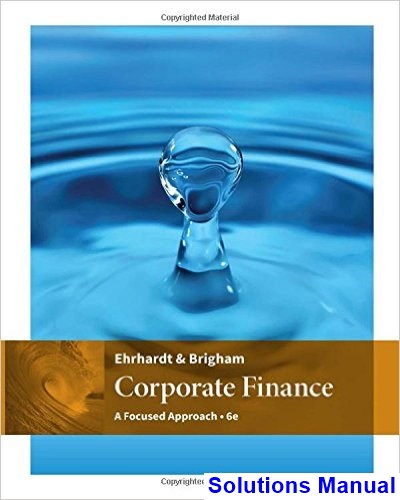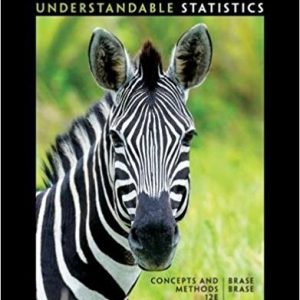This is completed downloadable of Corporate Finance A Focused Approach 6th Edition Ehrhardt Solutions Manual

Product Details:
- ISBN-10 : 1305637100
- ISBN-13 : 978-1305637108
- Author: Michael C. Ehrhardt, Eugene F. Brigham
Focus on the financial concepts, skills, and technological applications that are critical for you in today’s workplace with Ehrhardt/Brigham’s CORPORATE FINANCE: A FOCUSED APPROACH 6E. With its relevant and engaging presentation and numerous examples, you will learn the latest financial developments as you also learn how to maximize a firm’s value in today’s changing business environment. You will master the features and functions of spreadsheets by using chapter Excel Tool Kits, Build a Model problems, and Mini Cases that encourage “what-if” analysis on a real-time basis. As part of its comprehensive product package, Ehrhardt/Brigham’s CORPORATE FINANCE: A FOCUSED APPROACH 6E includes MindTap Finance, CengageNOW, and the best-selling Aplia™ Finance as optional learning solutions that complement the book’s focused presentation of corporate finance fundamentals and help you to become “First in Finance”.
Table of Content:
- Part 1: The Company and Its Environment
- Ch 1: An Overview of Financial Management and the Financial Environment
- 1-1: The Five-Minute MBA
- 1-2: Finance from 40,000 Feet Above
- 1-3: The Corporate Life Cycle
- 1-4: Governing a Corporation
- 1-5: An Overview of Financial Markets
- 1-6: Claims on Future Cash Flows: Types of Financial Securities
- 1-7: Claims on Future Cash Flows: The Required Rate of Return (The Cost of Money)
- 1-8: The Functions of Financial Institutions
- 1-9: Financial Markets
- 1-10: Overview of the U.S. Stock Markets
- 1-11: Trading in the Modern Stock Markets 10
- 1-12: Finance and the Great Recession of 2007
- 1-13: The Big Picture
- e-Resources
- Ch 1: Summary
- Ch 1: Questions
- Ch 1: Mini Case
- Ch 2: Financial Statements, Cash Flow, and Taxes
- 2-1: Financial Statements and Reports
- 2-2: The Balance Sheet
- 2-3: The Income Statement
- 2-4: Statement of Stockholders’ Equity
- 2-5: Statement of Cash Flows
- 2-6: Net Cash Flow
- 2-7: Free Cash Flow: The Cash Flow Available for Distribution to Investors
- 2-8: Performance Evaluation
- 2-9: The Federal Income Tax System
- Ch 2: Summary
- Ch 2: Questions
- Ch 2: Sels-Test-Problem
- Ch 2: Problems
- Ch 2: Spreadsheet Problems
- Ch 2: Mini Case
- Ch 3: Analysis of Financial Statements
- 3-1: Financial Analysis
- 3-2: Liquidity Ratios
- 3-3: Asset Management Ratios
- 3-4: Debt Management Ratios
- 3-5: Profitability Ratios
- 3-6: Market Value Ratios
- 3-7: Trend Analysis, Common Size Analysis, and Percentage Change Analysis
- 3-8: Tying the Ratios Together: The DuPont Equation
- 3-9: Comparative Ratios and Benchmarking
- 3-10: Uses and Limitations of Ratio Analysis
- 3-11: Looking Beyond the Numbers
- Ch 03: Summary
- Ch 03: Questions
- Ch 03: Self-Test-Problems
- Ch 03: Problems
- Ch 03: Spreadsheet Problem
- Ch 03: Mini Case
- Ch 03: Selected Additional Case
- Part 2: Fixed Income Securities
- Ch 4: Time Value of Money
- 4-1: Time Lines
- 4-2: Future Values
- 4-3: Present Values
- 4-4: Finding the Interest Rate, I
- 4-5: Finding the Number of Years, N
- 4-6: Perpetuities
- 4-7: Annuities
- 4-8: Future Value of an Ordinary Annuity
- 4-9: Future Value of an Annuity Due
- 4-10: Present Value of Ordinary Annuities and Annuities Due
- 4-11: Finding Annuity Payments, Periods, and Interest Rates
- 4-12: Uneven, or Irregular, Cash Flows
- 4-13: Future Value of an Uneven Cash Flow Stream
- 4-14: Solving for I with Irregular Cash Flows
- 4-15: Semiannual and Other Compounding Periods
- 4-16: Fractional Time Periods
- 4-17: Amortized Loans
- 4-18: Growing Annuities
- Ch 4: Summary
- Ch 4: Questions
- Ch 4: Self-Test-Problems
- Ch 4: Problems
- Ch 4: Spreadsheet Problem
- Ch 4: Mini Case
- Ch 5: Bonds, Bond Valuation, and Interest Rates
- 5-1: Who Issues Bonds?
- 5-2: Key Characteristics of Bonds
- 5-3: Bond Valuation
- 5-4: Changes in Bond Values Over Time
- 5-5: Bonds with Semiannual Coupons
- 5-6: Bond Yields
- 5-7: The Pre-Tax Cost of Debt: Determinants of Market Interest Rates
- 5-8: The Risk-Free Interest Rate: Nominal (rRF) and Real (r*)
- 5-9: The Inflation Premium (IP)
- 5-10: The Maturity Risk Premium (MRP)
- 5-11: The Default Risk Premium (DRP)
- 5-12: The Liquidity Premium (LP)
- 5-13: The Term Structure of Interest Rates
- 5-14: Financing with Junk Bonds
- 5-15: Bankruptcy and Reorganization
- Ch 5: Summary
- Ch 5: Questions
- Ch 5: Self-Test-Problems
- Ch 5: Problems
- Ch 5: Mini Case
- Ch 5: Selected Additional Case
- Part 3: Stocks and Options
- Ch 6: Risk and Return
- 6-1: Investment Returns and Risk
- 6-2: Measuring Risk for Discrete Distributions
- 6-3: Risk in a Continuous Distribution
- 6-4: Using Historical Data to Estimate Risk
- 6-5: Risk in a Portfolio Context
- 6-6: The Relevant Risk of a Stock: The Capital Asset Pricing Model (CAPM)
- 6-7: The Relationship between Risk and Return in the Capital Asset Pricing Model
- 6-8: The Efficient Markets Hypothesis
- 6-9: The Fama-French Three-Factor Model
- 6-10: Behavioral Finance
- 6-11: The CAPM and Market Efficiency: Implications for Corporate Managers and Investors
- Ch 6: Summary
- Ch 6: Questions
- Ch 6: Self-Test-Problems
- Ch 6: Problems
- Ch 6: Spreadsheet Problem
- Ch 6: Mini Case
- Ch 6: Selected Additional Case
- Ch 7: Corporate Valuation and Stock Valuation
- 7-1: Legal Rights and Privileges of Common Stockholders
- 7-2: Types of Common Stock
- 7-3: Stock Market Reporting
- 7-4: Valuing Common Stocks—Introducing the Free Cash Flow (FCF) Valuation Model
- 7-5: The Constant Growth Model: Valuation When Expected Free Cash Flow Grows ata Constant Rate
- 7-6: The Multistage Model: Valuation when Expected Short-Term Free Cash Flow Growsat a Nonconstant R
- 7-7: Application of the FCF Valuation Model to MicroDrive
- 7-8: Do Stock Values Reflect Long-Term or Short-Term Cash Flows?
- 7-9: Value-Based Management: Using the Free CashFlow Valuation Model to Identify Value Drivers
- 7-10: Why Are Stock Prices So Volatile?
- 7-11: Valuing Common Stocks with the Dividend Growth Model
- 7-12: The Market Multiple Method
- 7-13: Comparing the FCF Valuation Model, the Dividend Growth Model, and the Market Multiple Method
- 7-14: Preferred Stock
- Ch 7: Summary
- Ch 7: Questions
- Ch 7: Self-Test-Problems
- Ch 7: Problems
- Ch 7: Spreadsheet Problem
- Ch 7: Mini Case
- Ch 7: Selected Additional Case
- Ch 8: Financial Options and Applications in Corporate Finance
- 8-1: Overview of Financial Options
- 8-2: The Single-Period Binomial Option Pricing Approach
- 8-3: The Single-Period Binomial Option Pricing Formula
- 8-4: The Multi-Period Binomial Option Pricing Model
- 8-5: The Black-Scholes Option Pricing Model (OPM)
- 8-6: The Valuation of Put Options
- 8-7: Applications of Option Pricing in Corporate Finance
- Ch 8: Summary
- Ch 8: Questions
- Ch 8: Self-Test-Problems
- Ch 8: Problems
- Ch 8: Spreadsheet Problem
- Ch 8: Mini Case
- Part 4: Projects and Their Valuation
- Ch 9: The Cost of Capital
- 9-1: The Weighted Average Cost of Capital
- 9-2: Choosing Weights for the Weighted Average Cost of Capital
- 9-3: After-Tax Cost of Debt: rd(1 − T) and rstd(1 − T)
- 9-4: Cost of Preferred Stock, rps
- 9-5: Cost of Common Stock: The Market Risk Premium, RPM
- 9-6: Using the CAPM to Estimate the Cost of Common Stock, rs
- 9-7: Using the Dividend Growth Approach to Estimate the Cost of Common Stock
- 9-8: The Weighted Average Cost of Capital (WACC)
- 9-9: Adjusting the Cost of Equity for Flotation Costs
- 9-10: Privately Owned Firms and Small Businesses
- 9-11: The Divisional Cost of Capital
- 9-12: Estimating the Cost of Capital for Individual Projects
- 9-13: Managerial Issues and the Cost of Capital
- Ch 9: Summary
- Ch 9: Questions
- Ch 9: Self-Test-Problems
- Ch 9: Problems
- Ch 9: Spreadsheet Problem
- Ch 9: Mini Case
- Ch 9: Selected Additional Case
- Ch 10: The Basics of Capital Budgeting: Evaluating Cash Flows
- 10-1: An Overview of Capital Budgeting
- 10-2: The First Step in Project Analysis
- 10-3: Net Present Value (NPV)
- 10-4: Internal Rate of Return (IRR)
- 10-5: Modified Internal Rate of Return (MIRR)
- 10-6: Profitability Index (PI)
- 10-7: Payback Period
- 10-8: How to Use the Different Capital Budgeting Methods
- 10-9: Other Issues in Capital Budgeting
- Ch 10: Summary
- Ch 10: Questions
- Ch 10: Self-Test-Problems
- Ch 10: Problems
- Ch 10: Spreadsheet Problem
- Ch 10: Mini Case
- Ch 10: Selected Additional Case
- Ch 11: Cash Flow Estimation and Risk Analysis
- 11-1: Identifying Relevant Cash Flows
- 11-2: Analysis of an Expansion Project
- 11-3: Risk Analysis in Capital Budgeting
- 11-4: Measuring Stand-Alone Risk
- 11-5: Sensitivity Analysis
- 11-6: Scenario Analysis
- 11-7: Monte Carlo Simulation
- 11-8: Project Risk Conclusions
- 11-9: Replacement Analysis
- 11-10: Real Options
- 11-11: Phased Decisions and Decision Trees
- Ch 11: Summary
- Ch 11: Questions
- Ch 11: Self-Test-Problems
- Ch 11: Problems
- Ch 11: Spreadsheet Problem
- Ch 11: Mini Case
- Ch 11: Selected Additional Case
- APPENDIX 11A: Tax Depreciation
- Part 5: Corporate Valuation and Governance
- Ch 12: Corporate Valuation and Financial Planning
- 12-1: Overview of Financial Planning
- 12-2: Financial Planning at MicroDrive, Inc.
- 12-3: Forecasting Operations
- 12-4: Evaluating MicroDrive’s Strategic Initiatives
- 12-5: Projecting MicroDrive’s Financial Statements
- 12-6: Analysis and Selection of a Strategic Plan
- 12-7: The CFO’s Model
- 12-8: Additional Funds Needed (AFN) Equation Method
- 12-9: Forecasting When the Ratios Change
- Ch 12: Summary
- Ch 12: Questions
- Ch 12: Self-Test-Problems
- Ch 12: Problems
- Ch 12: Spreadsheet Problem
- Ch 12: Mini Case
- Ch 12: Selected Additional Case
- Ch 13: Corporate Governance
- 13-1: Agency Conflicts
- 13-2: Corporate Governance
- 13-3: Employee Stock Ownership Plans (ESOPs)
- Ch 13: Summary
- Ch 13: Questions
- Ch 13: Mini Case
- Part 6: Cash Distributions and Capital Structure
- Ch 14: Distributions to Shareholders: Dividends and Repurchases
- 14-1: An Overview of Cash Distributions
- 14-2: Procedures for Cash Distributions
- 14-3: Cash Distributions and Firm Value
- 14-4: Clientele Effect
- 14-5: Signaling Hypothesis
- 14-6: Implications for Dividend Stability
- 14-7: Setting the Target Distribution Level: The Residual Distribution Model
- 14-8: The Residual Distribution Model in Practice
- 14-9: A Tale of Two Cash Distributions: Dividends versus Stock Repurchases
- 14-10: The Pros and Cons of Dividends and Repurchases
- 14-11: Other Factors Influencing Distributions
- 14-12: Summarizing the Distribution Policy Decision
- 14-13: Stock Splits and Stock Dividends
- 14-14: Dividend Reinvestment Plans
- Ch 14: Summary
- Ch 14: Questions
- Ch 14: Self-Test-Problems
- Ch 14: Problems
- Ch 14: Spreadsheet Problem
- Ch 14: Mini Case
- Ch 14: Selected Additional Case
- Ch 15: Capital Structure Decisions
- 15-1: An Overview of Capital Structure
- 15-2: Business Risk and Financial Risk
- 15-3: Capital Structure Theory: The Modigliani and Miller Models
- 15-4: Capital Structure Theory: Beyond the Modigliani and Miller Models
- 15-5: Capital Structure Evidence and Implications
- 15-6: Estimating the Optimal Capital Structure
- 15-7: Anatomy of a Recapitalization
- 15-8: Risky Debt and Equity as an Option
- 15-9: Managing the Maturity Structure of Debt
- Ch 15: Summary
- Ch 15: Questions
- Ch 15: Self-Test-Problems
- Ch 15: Problems
- Ch 15: Spreadsheet Problem
- Ch 15: Mini Case
- Ch 15: Selected Additional Case
- Part 7: Managing Global Operations
- Ch 16: Supply Chains and Working Capital Management
- 16-1: Overview of Supply Chain Management
- 16-2: Using and Financing Operating Current Assets
- 16-3: The Cash Conversion Cycle
- 16-4: Inventory Management
- 16-5: Receivables Management
- 16-6: Accruals and Accounts Payable (Trade Credit)
- 16-7: The Cash Budget
- 16-8: Cash Management and the Target Cash Balance
- 16-9: Cash Management Techniques
- 16-10: Managing Short-Term Investments
- 16-11: Short-Term Financing
- 16-12: Short-Term Bank Loans
- 16-13: Commercial Paper
- 16-14: Use of Security in Short-Term Financing
- Ch 16: Summary
- Ch 16: Questions
- Ch 16: Self-Test-Problems
- Ch 16: Problems
- Ch 16: Spreadsheet Problem
- Ch 16: Mini Case
- Ch 16: Selected Additional Case
- Ch 17: Multinational Financial Management
- 17-1: Multinational, or Global, Corporations
- 17-2: Multinational versus Domestic Financial Management
- 17-3: Exchange Rates
- 17-4: Exchange Rates and International Trade
- 17-5: The International Monetary System and Exchange Rate Policies
- 17-6: Trading in Foreign Exchange
- 17-7: Interest Rate Parity
- 17-8: Purchasing Power Parity
- 17-9: Inflation, Interest Rates, and Exchange Rates
- 17-10: International Money and Capital Markets
- 17-11: Multinational Capital Budgeting
- 17-12: International Capital Structures
- 17-13: Multinational Working Capital Management
- Ch 17: Summary
- Ch 17: Questions
- Ch 17: Self-Test-Problems
- Ch 17: Problems
- Ch 17: Spreadsheet Problem
- Ch 17: Mini Case
- Ch 17: Selected Additional Case
- Appendix A: Solutions to Self-Test Problems
- Appendix B: Answers to End-of-Chapter Problems
- Appendix C: Selected Equations
- Appendix D: Values of the Areas under the Standard Normal Distribution Function
- Glossary
- Name Index
- Subject Index





